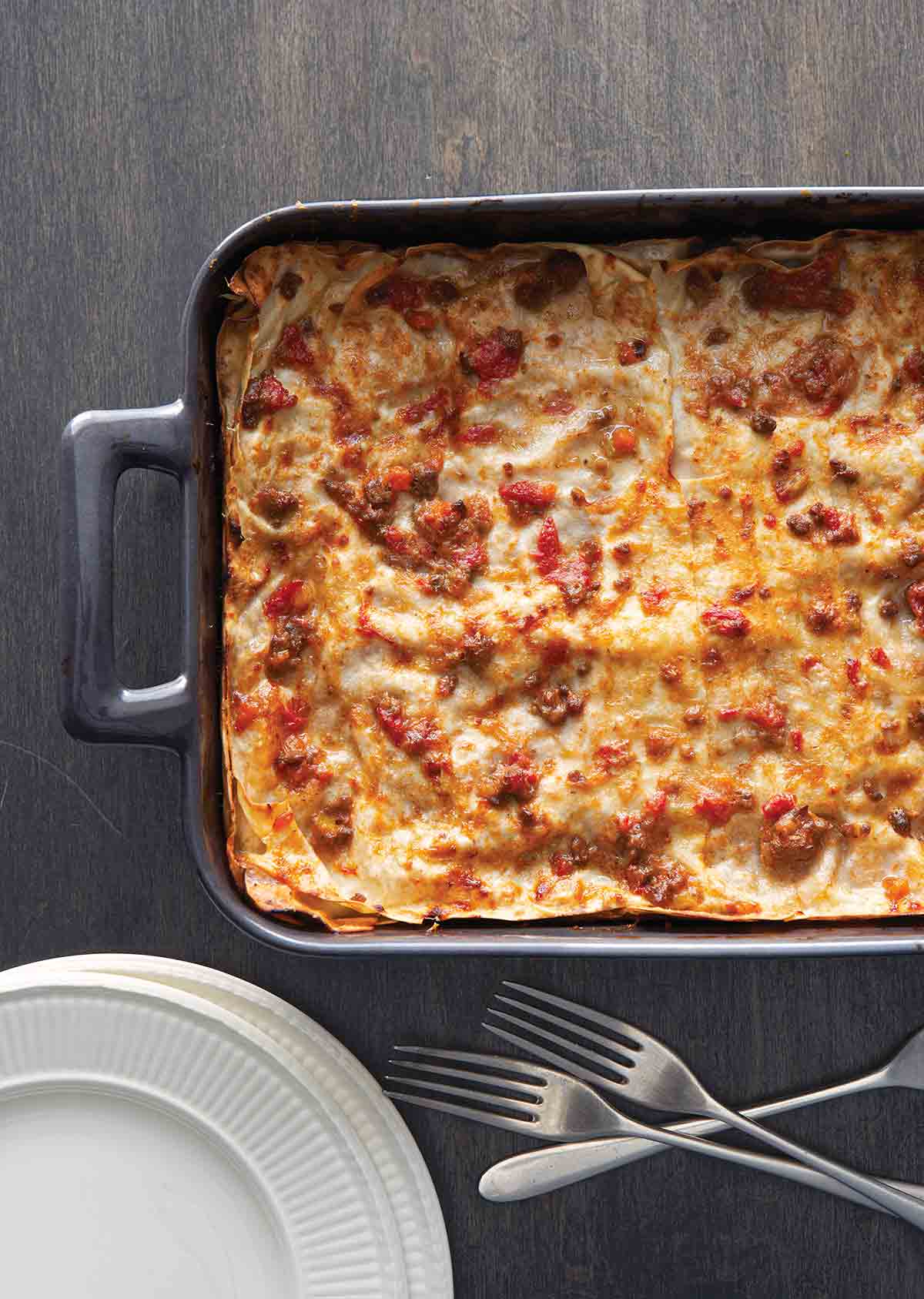
I’ve always looked upon making my own pasta as a virtuous endeavor. Like tithing, volunteering, or rotating my tires on a regular basis. So when I told The One I was going to make Giuliano’s lasagne with homemade noodles, he gave me a very impressed nod of the head. I liked that. He was even more intrigued when I hauled out all my new KitchenAid rollers and cutters along with a ruler, broomstick, and 00 flour. Clearly I meant business.
Jump To
This recipe is a cinch to follow. Guiliano writes that you can make it over two days, but if you’re organized (which I’m not), you can make in an afternoon—which I did.
My only problem was that I had to stop rolling the dough two settings before the narrowest setting that the recipe specified because the dough was stretching too thin. Thinking I perhaps made a mistake and had already rolled it into pasta oblivion (after all, I was picturing those hefty-hefty, thick-as-plywood lasagna noodles of days gone by).
Marcella Hazan Wrote Me About My Pasta!
I posted a picture on Facebook in the hopes of getting feedback. And who should reply? None other than the doyen of Italian cooking—Marcella Hazan.
She wrote, “Nice touch David, to lay out the pasta on checked fabric to display its transparency. Homemade egg pasta is at the top of the pasta pyramid, and homemade lasagne alla Bolognese commands the very peak. Why have so few refused to make that ascent? Congrats, D.L.”
As you can imagine, I was practically vibrating with pride.
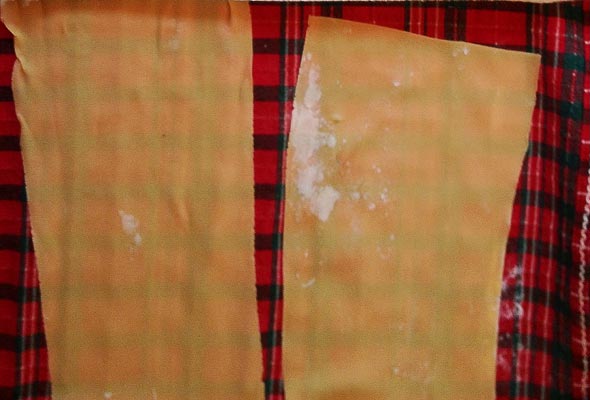
A Cooking Suggestion
Make sure to use a very thin layer of sauce between the sheets of pasta, as it helps create more layers, which benefits this dish. Also, when you’re transferring the pasta sheets from the pot to the bowl of ice water, use a wide plastic spatula and tongs. It prevent the pasta from tearing. I have a pair of OXO tongs with nylon tips, and they were great for gripping but not ripping.
What I found unusual is that Guiliano mixes the Bolognese sauce with the béchamel. I’ve always alternated them between the layers of pasta. Did I like it? Let’s just say The One chided me more than once for eating it right out of the pot. I also alternated layers of regular pasta and spinach pasta to great effect. (I really wanted to impress my guests.)
The result? Everyone. Loved. It. The lasagne was surprisingly light. It was so light, our guests were able to eat two pieces each, something that displeased The One and me immensely because there were no leftovers. None. Nada. Zilch. I guess one of our well-fed guests summed it up perfectly: “It was the best I ever had.” Next time I make this, we’re inviting no one.
From Giuliano Hazan
Lasagne—the Italian plural of lasagna, which refers to just one sheet of pasta—is one of our family’s favorite foods. Lovingly and carefully made, Italian lasagne bears no resemblance whatsoever to those heavy American things that rest in the pit of your stomach for days after being consumed.
Bolognese lasagne is a delicate dish that is light, almost airy. It is a savory concoction, with each creamy bite melting in your mouth. It must be made with homemade egg noodles, and there is NO ricotta to be found in any of the Hazans’ recipes.
My father adores green lasagne, and it is what he always requests when we celebrate his birthday at our house. My wife, Lael, who before I met her was quite indifferent to lasagne, now always asks me to make it for her birthday as well.
Lasagne are often judged on how many layers they have. Five or six layers are considered the minimum. For Lael’s most recent birthday celebration, I made a spectacular nine-layer lasagne. It was absolutely worth every ounce of effort that went into making it.
In addition to being a principal component of lasagne Bolognese, Bolognese sauce is so good on its own that it is a staple in our house. It freezes very well, so whenever I make it, I always make enough to last us for three or four meals. Its ideal pairing is with homemade egg pasta, particularly pappardelle, but it’s also wonderful with chewy, substantial shapes of dried flour-and-water pasta such as rigatoni, shells, and cartwheels. It’s not at all suited to spaghetti, which does not catch the sauce well. (Spaghetti with meat sauce is found in Italian-American cuisine but never in Italy.)
The sauce recipe below makes enough for 1 pound of dried pasta. In Italian, béchamel is called besciamella, and the dispute as to whether it was the Italians or the French who invented it will probably never be resolved. It is a white sauce that is quite commonly used in Emilia-Romagna, particularly in baked pasta dishes. It is easy enough that a child can make it (with supervision), and our kids have become quite proficient at it.
LC What To Do When Note
As Giuliano Hazan (yes, that Hazan) explains in his book, Hazan Family Favorites, he has “a routine now” when he makes lasagne, which makes the process “fairly easy.” His secret? He savvily spreads the cooking of this epic, authentic lasagne over two days:
“The first day I make the Bolognese sauce, which only requires about 30 minutes of my time—because once all the ingredients are in, it cooks on its own.
“The second day, I begin by making the dough for the pasta; while it rests, I make the béchamel. Then I roll out the pasta, cook it, and assemble the lasagne. The second day’s work requires a little over an hour of my time, not counting baking the lasagne.”
Seems simple—and doable—enough to us.
Equipment
- Pasta roller
Ingredients
For the Bolognese meat sauce
- 1/2 medium yellow onion
- 1 medium carrot
- 1 stalk celery
- 3 tablespoons (1 1/2 oz) butter
- 2 tablespoons extra-virgin olive oil
- 12 ounces ground beef, preferably chuck
- 1/2 cup dry white wine
- 1/2 cup whole milk
- 1/8 teaspoon nutmeg
- 2 cups canned whole peeled tomatoes with their juices
- 1 1/4 teaspoons salt
For the lasagna noodles
- 2 1/4 cups all-purpose unbleached flour
- 3 eggs
For the béchamel sauce
- 2 cups whole milk
- 4 tablespoons (2 oz) butter
- 4 tablespoons flour
- 1/2 teaspoon salt
For the lasagne assembly
- Salt, for the cooking water
- 3/4 cup freshly grated Parmigiano-Reggiano
- 1 tablespoon (1/2 oz) butter, cut into pieces
Instructions
Make the Bolognese meat sauce
- Peel and finely chop the onion. Peel the carrot and celery and cut into 1/4-inch dice. Place the onion, carrot, celery, butter, and olive oil in a heavy-bottomed sauce pot over medium-high heat. Sauté, stirring occasionally, until the vegetables are lightly browned, about 10 minutes.
- Add the ground beef and break it up with a wooden spoon. Add the wine and cook, stirring occasionally, until almost half the liquid has evaporated. Add the milk and nutmeg and cook, stirring occasionally, until half the milk has evaporated.
- Coarsely chop the tomatoes and add them along with their juice and the salt to the pot. Once the tomatoes have started bubbling, turn down the heat to very low so that the sauce is barely simmering. Cook, uncovered, for 3 hours, stirring every 15 to 20 minutes. If all the liquid evaporates before the cooking time is up, add water in 1-cup increments as needed. Make sure all the liquid has evaporated before removing the sauce from the heat. (You can prepare the sauce ahead of time and refrigerate it for up to 3 days or freeze it for up to 2 months.)
Make the pasta
- Pour the flour in a mound in the center of your work counter. With your fingers, dig down in the center of the flour and when your fingers reach the counter, push the sides out to make a well in which the eggs will fit comfortably. (It’s better to make the well a little wider than necessary than too small and risk the eggs overflowing.)
- Break the eggs into the center of the well. Using a fork, beat the eggs as if you were making scrambled eggs until the yolks and the whites are thoroughly blended together. Use the fork to mix a little flour from the bottom of the inside walls of the well into the eggs. Continue until the mixture thickens enough to cling to the fork when you lift it into the air. Use your fingers to squeeze the dough attached to the fork back into the well and set the fork aside. Push about 1/4 cup flour to the side, then use your hands to bring the rest into the center of the well. Mix together with your hands until a dough that clings together begins to form. If the dough feels sticky when you plunge a finger into it, add a little more flour. The dough should feel moist but not sticky. Wrap the dough in plastic wrap (the surface of the dough can begin to dry out in as little as a minute) and then scrape off any bits of dough that have stuck to the counter. Reserve any remaining flour off to the side.
- Unwrap the dough and begin kneading it. Think of stretching the dough rather than compressing it by using the heel of your palm and pushing away from you. Knead until the dough feels homogeneous and smooth. If it seems to stick to your hand or to the counter, add a little more flour. On the other hand, if it feels too hard to knead, you may have added too much flour. Try wetting your hands and kneading the moisture in. If that doesn’t seem to help, it’s probably easier and faster to start over. If you don’t need to add any more flour while kneading, it should only take 5 to 6 minutes. Adding flour during the kneading process may increase the time since the further along you are, the longer it takes for the flour to get incorporated. When you’ve kneaded the dough sufficiently, wrap it in plastic wrap again and let it rest for at least 15 minutes or up to 3 hours. Never refrigerate or freeze pasta dough. As the dough rests, the gluten in the flour will relax, making it much easier to roll the dough.
- After the dough has rested, unwrap it and knead it a few times to incorporate the moisture that inevitably rises to the surface. The surface of the dough at this point should feel silky smooth (a baby’s bottom is the traditional comparison).
- Cut the dough into 4 pieces. Wrap 3 of the pieces in the plastic wrap. Flatten the remaining piece of dough as best you can with your hands then put it through the rollers of the machine set at the widest setting. Fold the dough in 3, and put it through the rollers again with the folds perpendicular to the rollers. Fold the dough in half and put it through one more time, again with the folds perpendicular to the rollers. Lay the dough on a towel and repeat the procedure with the remaining 3 pieces.
- When all the pieces have been through the machine at the widest setting, adjust the rollers down one notch and put each piece of dough through once. Repeat, going down one notch at time, until you reach the next to last setting. Cut each sheet of pasta in half, then put each piece through the machine at the thinnest setting. Wrap the pasta in plastic wrap and set aside to rest.
Make the béchamel sauce
- Pour the milk into a small saucepan and place over medium heat until steam is released when the milk is stirred. This happens just before it comes to a boil.
- While the milk is heating, melt the butter in a 2-quart saucepan over medium-low heat. Add the flour, mixing it in with a whisk until the mixture is smooth. Cook, whisking constantly, for about 1 minute. Do not let the flour brown. Remove the pan from the heat.
- When the milk is hot, transfer it to a measuring cup or pitcher with a spout. Return the pan with the flour mixture to medium heat and begin adding the hot milk, very slowly at first, mixing with the whisk. Do not be concerned if the mixture becomes quite thick at first. Continue adding the milk slowly while mixing with the whisk. As the consistency becomes thinner, start adding the milk more rapidly until all of it has been mixed in. Add the salt and cook over medium heat, still whisking constantly, until the sauce begins to thicken, 10 to 15 minutes. The sauce is done when it coats the whisk thickly. (You should have about 2 cups.) Béchamel is best when used the same day but will keep overnight in the refrigerator if necessary. It’s not necessary to reheat it before using.
Assemble the lasagne
- When the Bolognese sauce is ready, fill a pot for the pasta with at least 6 quarts water, place it over high heat, and bring it to a boil.
- Fill a large bowl halfway with ice and water and keep it close to the pot of water on the stove.
- Add 2 tablespoons salt to the boiling water and carefully add 4 of the pasta sheets. Cook for 1 minute, then gently lift the pasta out of the water using rubber-tipped tongs and a spatula (so as not to rip the pasta sheets) and place the pasta in the bowl of ice water. Gently swish the pasta sheets in the water, then lay them flat on dry towels. Repeat with the remaining 4 pasta sheets.
- Preheat the oven to 425°F (218°C).
- Spread a thin coating of béchamel on the bottom of an 8-by-11 1/2-inch baking dish. Mix the remaining béchamel with the Bolognese sauce and 1/2 cup Parmigiano-Reggiano.
- Use the bottom of the baking dish as a template and cut a piece of pasta to fit it. Cut the remaining pieces of pasta the same size and reserve any scraps of pasta. Place 1 pasta sheet in the dish. If you miscalculated and the pasta doesn’t quite cover the bottom of the dish, cut the scraps of pasta into smaller strips to cover any exposed area. Spread a thin coating of the filling over the pasta, then cover with another pasta sheet. Continue until you have 6 or more layers of pasta and filling, reserving a little of the filling to cover the top layer of pasta. Sprinkle the remaining 1/4 cup Parmigiano-Reggiano over the top and dot with the butter. (The lasagne can be assembled completely up to 1 day in advance and kept, well wrapped, in the refrigerator. Remove it from the refrigerator 1 hour before baking.)
- Bake until the top of the lasagne is lightly browned, 20 to 25 minutes. Take the lasagne out of the oven and let it rest for 5 minutes before serving. (The lasagne will keep in the refrigerator after it is baked for up to 2 days.)
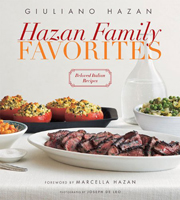
Nutrition
Nutrition information is automatically calculated, so should only be used as an approximation.


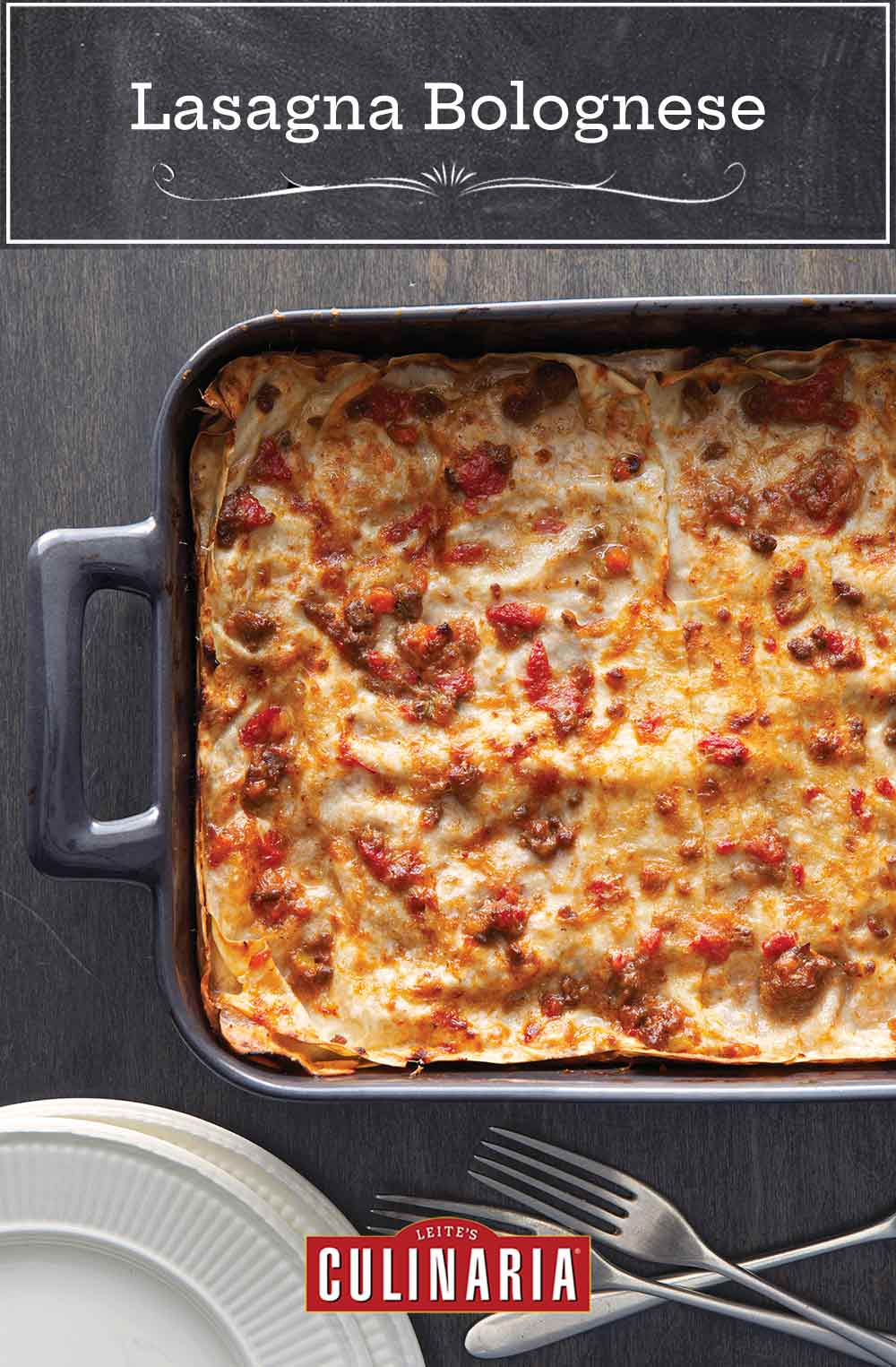
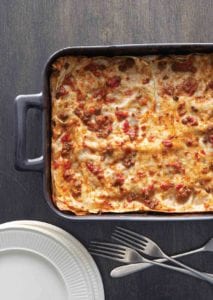










Fabulous! I made this lasagna last night and it received rave reviews. I made the bolognese sauce in the crockpot the night before and then finished assembling the dish in the morning. The sauce is tangy and flavorful, but not overly heavy. There was really good balance overall. I really liked that there was not a lot of cheese in the sauce to compete with the tomatoes and pasta. I added the cheese to the bechamel sauce and added sauted zucchini, mushrooms, and spinach to the sauce. Due to time constraints, I did not make my own pasta but I did buy sheets from a local Italian deli. I live with three picky eaters who do not really like tomato sauces, but they devoured it. This will become a regular in our house.
Jessica, musica per le mie orecchie. (I have no idea if I wrote that correctly, but it is indeed music to my ears. Glad we could help add another recipe to the roster at Chez Jessica.
Hello, for the 2 cups canned whole tomatoes can you please specify what size can that would be, ie. should I only use 16oz can. I’m concerned I might not use the right amount of tomatoes thank you!!
Audrey, a 16-ounce can should cover you, because 2 cups equals 16 ounces. But why not get a 28-ounce can and have a little extra tomatoes for something else? More economical that way.
Thank you so much David!
You bet, Audrey.
I have a two month old baby, so I’m not up to making fresh pasta this time 🙂 However, I want to try the sauces with Papperdelle from Trader Joe’s. How long do you think I should cook the pasta before assembling the baked dish?
Katie, the lasagna noodles cook for so little because they’re fresh. I would cook the pappardelle a few minutes shy of the time specified on the package. You want it to be al dente so that it can finish cooking in the oven.